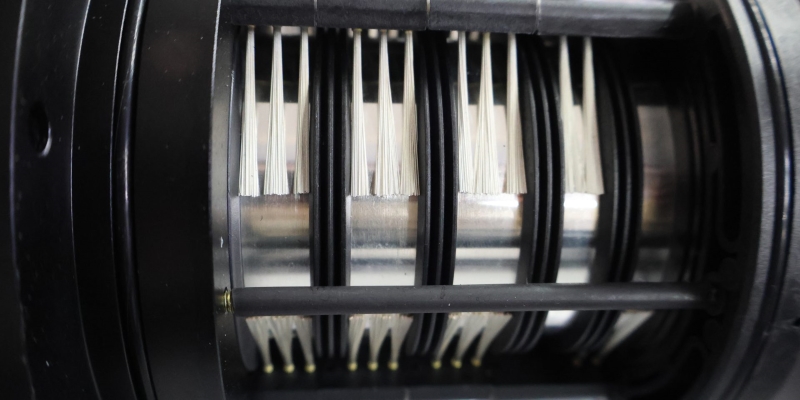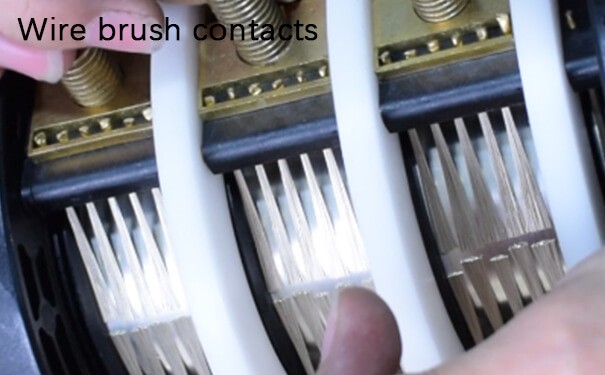Slip rings, otherwise known as rotary electrical interfaces or rotary electrical joints, serve as vital components in a multitude of technical applications. These ingeniously designed electromechanical devices facilitate the transfer of both power and electrical signals into and from rotating equipment. From wind turbines that harness sustainable energy to advanced robotic machinery, from surveillance systems to sophisticated medical devices, the use of slip rings is ubiquitous.
In such a sweeping array of applications, each with unique operative conditions and demands, slip rings reliably ensure a stable electrical connection. Their role becomes even more pivotal in systems with continuous or intermittent rotation where traditional wired connectivity might falter.
However, the efficiency and longevity of slip rings are not solely an outcome of their structural framework or design alone. Brush materials, the unsung heroes in the architecture of a slip ring, play a critical role in its functionality. These brushes, typically made from a variety of materials like metal, carbon, or composite blends, form the contact pieces that slide over the rotating surface of the slip ring.
The function of the slip ring brush material is dual-pronged: it is responsible for supplying the electric current or signals to the contact surface, as well as collecting the signals or current back. As the slip ring brush material handles the full force of friction, wear, and electrical loading, its selection becomes a crucial factor in the efficiency, mechanical wear tolerance, and service life of the slip rings. Furthermore, the composition, quality, and compatibility of the slip ring brush material with the slip ring surface can notably affect the performance, reliability, and maintenance requirements of the overall system. Consequently, understanding the characteristics and function of the slip ring brush material becomes essential for individuals working with systems involving slip rings.
Assortment of Brush Materials Used in Slip Rings
In the broad spectrum of brush materials leveraged in slip rings, three key categories emerge metallic brushes, carbon brushes, and composite brushes.
Firstly, metallic brushes encompass materials like silver, gold, and copper. They are commonly employed owing to their impressive electrical conducting capabilities. Silver brushes, for instance, due to their excellent conductivity and low contact resistance, are the ideal choice for high-frequency signal transmission applications. Gold brushes, although expensive, are known for their high conductivity coupled with exceptional resistance to corrosion. This makes them perfect for environments that demand higher reliability or where minimal electrical noise is a priority. Copper brushes, on the other hand, are an economical option, offering good overall performance particularly suited to power transmission applications.
Moving onto carbon brushes, these typically incorporate materials such as graphite or silver-graphite. Graphite’s attributes of low friction, high-temperature tolerance, and moderate electrical conductivity make it a preferred choice for high-speed or high-temperature applications. With the inclusion of silver in graphite brushes, one can achieve improved conductivity without sacrificing the low friction properties of graphite.
Lastly, we have composite brushes where metals and carbon materials are blended together. These benefit most applications as they provide the good electrical conductivity of metals coupled with the durability, high-temperature performance, and lower friction characteristics of carbon/graphite. A widely used composite material is silver graphite which provides a balance of conductivity, friction, and brush life.
Each of these brush material types has unique advantages, fitting different application requirements, but they also carry certain drawbacks. Metallic brushes, while excellent conductors, deal with faster mechanical wear due to higher friction and might not be ideal for high-speed operations. Carbon brushes, although resistant to high temperatures and less frictional wear, suffer from a lack of conductivity compared to their metal counterparts. Composite brushes, despite achieving balance, might not be fully optimized for extreme applications and their performance can vary considerably depending on the exact blend of materials. Thus, understanding the trade-offs between these brush materials is critical for the optimal selection for a specific slip ring application.

Crucial Considerations for Selecting Slip Ring Brush Material
Choosing the right brush material for your slip ring application has a significant impact on their performance and longevity. Here are the most critical factors to keep in mind:
- Ability to carry current: The first and foremost factor to look into is the capacity of the material to transmit electric current, a primary function of the brush. The brush material you pick should provide an efficient passage for the current without contributing excessive resistance, therefore maintaining a seamless electrical connection.
- Resistance to electrical contact: Contact resistance refers to the resistance when current travels from the brush into the rotating contact ring. Certain brush materials can lead to an increased level of resistance, resulting in potential heat buildup and power loss. selection should promote a low level of electrical contact resistance.
- Durability including wear properties and brush lifespan: The brush material should possess high durability, considering the constant mechanical stress it experiences due to the frictional contact with the rotating ring. The wear properties of the material directly influence the replacement intervals and lifespan of the brushes.
- Environmental Conditions: The operating conditions in which the slip ring functions immensely affect the selection of brush material. For instance, applications operating at high temperatures necessitate materials like carbon brushes that can withstand such conditions; likewise, in humid environments, corrosion-resistant materials like gold are ideal.
- Financial aspects: cost and availability: Although maintaining optimum electrical performance is paramount, cost and availability are practical considerations that cannot be ignored. The decision should strike a balance between cost-effectiveness and performance demands.
- Compatibility with the slip ring material: Lastly, it is vital to ensure that the chosen brush material is compatible with the contact ring material of the slip ring. Incompatible materials can result in increased wear and tear, reducing slip ring lifespan and reliability.
Keeping these considerations in check can assist in determining the most suitable brush material for your slip ring application, potentially enhancing its performance and lifespan while minimizing downtime for maintenance or replacement.
Typical Uses and Suggested Materials
Given the variety of industries that slip rings find a place in, there’s understandably a range of brush materials suited to different scenarios. Let’s delve into the specific requirements of various applications and the recommended brush materials for each:
- Wind Energy Harnessing: Wind turbines often have to deal with high-speed operations and harsh environmental conditions. Here, the ability of carbon brushes to withstand high temperatures, deliver low friction at high speeds, and their commendable durability makes them an excellent choice for such applications.
- Medical Devices and Equipment: In medical applications, precision and reliability are paramount. As such, gold or silver brushes are commonly employed due to their superior conductivity, low electrical noise, and corrosion resistance, proving crucial when dealing with sensitive signals or patient-related data.
- Heavy-Duty Industrial Machinery: Industrial machinery often involves high-power transmission and operates in challenging conditions, demanding an extended lifespan. Composite brushes combining both metal and carbon materials provide a balance of conductivity, durability, and wear resistance, making them ideally suited for such scenarios.
- Robotics and Automated Systems: In robotics and automation systems, operation speeds can vary, and the focus skews towards durability and consistent performance over time. Composite brushes find favor here as well, due to their balanced performance characteristics and all-rounded performance.
- Surveillance Hardware Including CCTV: Constant rotation is typical in surveillance systems like CCTV, with a high premium on reliability and long service life. Carbon or composite brushes offer low friction and good durability, maintaining smooth rotation and service longevity.
- Maritime Applications: Maritime conditions entail more exposure to humidity and potentially corrosive environments. Brushes with high corrosion resistance, such as composite or metal brushes, tend to be preferred for these applications.

Regardless of the specific industry or application, the choice of brush material should optimize a balance between performance requirements, lifespan, cost, and environmental considerations.
Upkeep and Maintenance of Brush Materials in Slip Rings
The role of slip rings in enabling smooth operations and ensuring reliable performance of rotating equipment necessitates that they receive regular upkeep and maintenance. This is particularly true for the brush materials, which directly bear the friction and wear during service.
- Emphasizing the necessity for regular maintenance: Regular maintenance is crucial to ensure the functional longevity of slip rings. Factoring in the continuous contact and friction that the brush materials endure, timely inspections are essential to monitor signs of excessive wear, heat, or damage. Regular maintenance allows early detection of problems and prevents unforeseen system failures.
- Standard for cleaning procedures: Proper cleaning is an integral part of maintenance. The presence of dust or foreign particles could hamper electrical contact, leading to issues such as sparking or overheating. The cleaning procedure, however, depends on the specific type of brush material and often involves special treatments or carefully chosen cleaning agents. For instance, metallic brushes may be cleaned using alcohol-based solutions, while carbon brushes might necessitate specialized carbon-cleaning compounds.
- Guidance on brush replacement and troubleshooting methods: Despite regular maintenance, a brush may eventually reach the end of its service life. Understanding the signs of wear, such as uneven wearing, chipping, or cracking, proves beneficial in deciding when to replace the brushes. Furthermore, troubleshooting methods, such as testing circuit continuity or visually inspecting for signs of overheating, can be advantageous in diagnosing issues and deciding the best course of action.
Undoubtedly, attention to the upkeep and maintenance of slip rings, specifically the brush materials, is an investment in the long-term reliability and peak performance of the overall system. By staying mindful of the maintenance needs and ensuring these activities are performed diligently, one can significantly extend the service life of the slip rings.
Conclude
The selection of slip ring brush material is a critical aspect that warrants conscious consideration. It significantly influences the performance and durability of the slip ring, hence impacting the overall efficiency of the system it serves. By choosing a brush material that aligns with the specific application requirements, one can ensure optimal performance and longevity.
FAQs about Slip Ring Brush Material
To help users better understand the significant aspects of slip ring brush materials, a compilation of frequently asked questions, along with concise responses, is presented below.
Q1: Why is the choice of brush material critical for a slip ring’s performance?
A: The brush material directly influences the electrical conductivity, friction, wear resistance, and lifespan of a slip ring. Therefore, choosing an appropriate brush material is essential for maintaining the desired performance, long service life, and minimal downtime during application.
Q2: What factors should be considered while selecting the slip ring brush material?
A: Key factors to take into account include the material’s ability to carry current, resistance to electrical contact, durability, environmental conditions, cost and availability, and compatibility with the slip ring material.
Q3: What materials are commonly used for slip ring brushes?
A: The most commonly used materials for slip rings brushes are metallic brushes (e.g., silver, gold, and copper), carbon brushes (e.g., graphite or silver-graphite), and composite brushes (a blend of metal and carbon materials, such as silver-graphite).
Q4: How do I determine the best brush material for my specific application?
A: Analyze the requirements of your application, such as the operational speed, temperature tolerance, conductivity needs, and environmental conditions. Then, consider the strengths and weaknesses of each brush material type to find the one that matches your criteria.
Q5: How do I maintain brush materials to ensure a longer operating life for my slip ring?
A: Regular maintenance is essential and should include routine inspections, cleaning depending on the material type, and timely replacement when excessive wear or damage is observed. Adhering to recommended troubleshooting methods will further help maintain the functionality of your slip ring.
See What We Can Do

